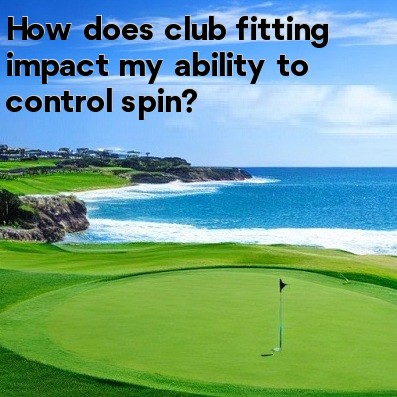
When it comes to controlling spin in golf, club fitting plays a crucial role. The right equipment can significantly impact both the amount of spin you generate and your ability to control it. Let's explore how club fitting can affect your spin control:
- Clubhead Design: The design of the clubhead can influence the amount of backspin or topspin you produce. Clubs with a higher center of gravity tend to produce less spin and a lower launch angle, while clubs with a lower center of gravity generate more spin and a higher launch angle. Club fitting helps determine the clubhead design that suits your swing and spin preferences.
- Shaft Flexibility: The flexibility of the shaft affects how much the clubface will close or open during impact. A stiffer shaft generally reduces spin and promotes a straighter ball flight, while a more flexible shaft can increase spin and allow for more shot-shaping options. Club fitting helps determine the optimal shaft flexibility for your swing mechanics and spin control needs.
- Shaft Weight: The weight of the shaft can influence your ability to control spin. A heavier shaft often leads to lower spin rates and a more penetrating ball flight, while a lighter shaft tends to increase spin and provide more launch. By experimenting with different shaft weights during club fitting, you can find the one that enhances your spin control abilities.
- Club Length: The length of the club can affect the spin you generate on your shots. A longer club generally leads to more clubhead speed, resulting in higher spin rates. However, controlling the clubhead becomes more challenging with longer clubs, especially in terms of spin control. Club fitting helps determine the ideal club length for your swing mechanics and spin control needs.
- Club Loft: The loft of a club directly influences the spin rate. Lower lofts produce less spin, while higher lofts generate more spin. Club fitting helps determine the appropriate loft angles for your clubs, allowing you to optimize spin control based on your swing characteristics and course conditions.
- Groove Configuration: The groove configuration on your clubface can impact spin control. Shallow and closely spaced grooves tend to reduce spin, while deep and widely spaced grooves increase spin. Modern club fitting takes into account the groove configuration to ensure your clubs provide optimal spin control.
By undergoing a proper club fitting session, you can fine-tune your equipment to maximize your ability to control spin. A professional club fitter will consider various factors such as your swing speed, launch angle, and shot dispersion patterns to recommend the best combination of clubhead design, shaft flexibility, weight, length, loft, and groove configuration.
Remember that achieving optimal spin control is not just about the equipment; it also requires proper technique and practice. However, having clubs that are specifically fitted for your game can undoubtedly improve your ability to control spin, allowing you to hit the shots you desire and adapt to various course conditions.
To summarize, club fitting plays a vital role in controlling spin in golf. It helps determine the optimal clubhead design, shaft flexibility, weight, length, loft, and groove configuration for your swing mechanics and spin control needs. By investing in a custom club fitting session, you will be equipped with the right tools to enhance your spin control abilities and ultimately improve your overall performance on the golf course.





